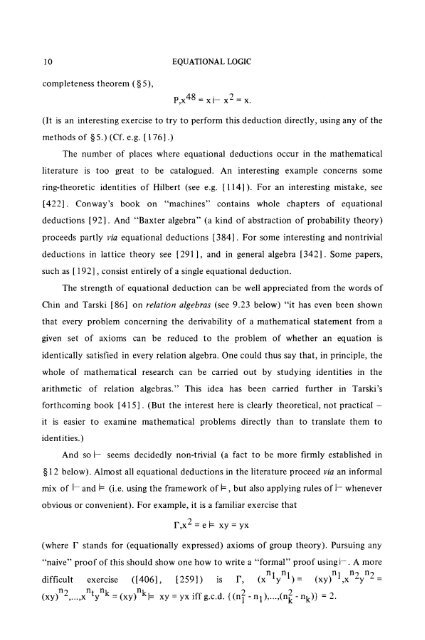Survey 1979: Equational Logic - Department of Mathematics ...
Survey 1979: Equational Logic - Department of Mathematics ...
Survey 1979: Equational Logic - Department of Mathematics ...
Create successful ePaper yourself
Turn your PDF publications into a flip-book with our unique Google optimized e-Paper software.
10 EQUATIONAL LOGIC<br />
completeness theorem (õ 5),<br />
P,x 48 = x i- x 2 = x.<br />
(It is an interesting exercise to try to perform this deduction directly, using any <strong>of</strong> the<br />
methods <strong>of</strong> õ5.) (Cf. e.g. [ 176] .)<br />
The number <strong>of</strong> places where equational deductions occur in the mathematical<br />
literature is too great to be catalogued. An interesting example concerns some<br />
ring-theoretic identities <strong>of</strong> Hilbert (see e.g. [ 114]). For an interesting mistake, see<br />
[422]. Conway's book on "machines" contains whole chapters <strong>of</strong> equational<br />
deductions [92]. And "Baxter algebra" (a kind <strong>of</strong> abstraction <strong>of</strong> probability theory)<br />
proceeds partly via equational deductions [384]. For some interesting and nontrivial<br />
deductions in lattice theory see [291], and in general algebra [342]. Some papers,<br />
such as [ 192], consist entirely <strong>of</strong> a single equational deduction.<br />
The strength <strong>of</strong> equational deduction can be well appreciated from the words <strong>of</strong><br />
Chin and Tarski [86] on relation algebras (see 9.23 below) "it has even been shown<br />
that every problem concerning the derivability <strong>of</strong> a mathematical statement from a<br />
given set <strong>of</strong> axioms can be reduced to the problem <strong>of</strong> whether an equation is<br />
identically satisfied in every relation algebra. One could thus say that, in principle, the<br />
whole <strong>of</strong> mathematical research can be carried out by studying identities in the<br />
arithmetic <strong>of</strong> relation algebras." This idea has been carried further in Tarski's<br />
forthcoming book [415]. (But the interest here is clearly theoretical, not practical -<br />
it is easier to examine mathematical problems directly than to translate them to<br />
identities.)<br />
And so 1- seems decidedly non-trivial (a fact to be more firmly established in<br />
õ 12 below). Almost all equational deductions in the literature proceed via an informal<br />
mix <strong>of</strong> I- and (i.e. using the framework <strong>of</strong> , but also applying rules <strong>of</strong> l- whenever<br />
obvious or convenient). For example, it is a familiar exercise that<br />
F,x 2=e xy =yx<br />
(where F stands for (equationally expressed) axioms <strong>of</strong> group theory). Pursuing any<br />
"naive" pro<strong>of</strong> <strong>of</strong> this should show one how to write a "formal" pro<strong>of</strong> using l-. A more<br />
difficult exercise ([406], [259]) is I', (xnly nl ) = (xy)nl,xn2y n2 =<br />
(xy) n, %...,x n, [y m. "=(xy)nk xy =yxiffg.c.d.{(n 12 -nl),...,(nk-nk) 2 } =2.

















